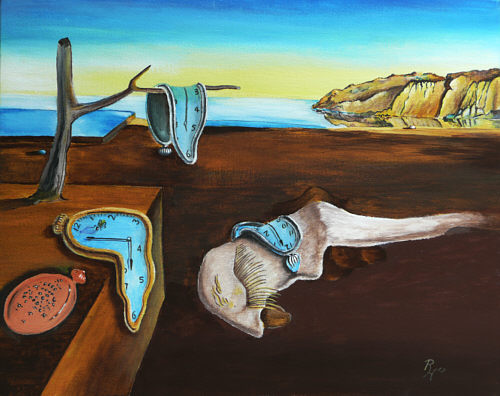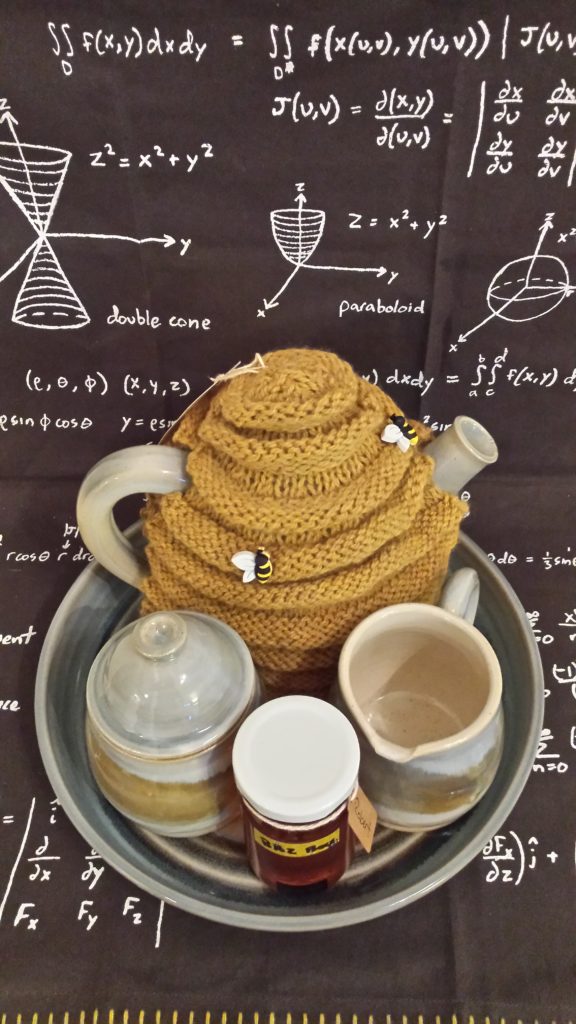I often make reference to sampling the readings and communing in the Collective Unconscious. Pour a cup of tea, and let’s talk about that.

The Collective Unconscious. I know it sounds silly/sappy/stupid (toss-out any adjective invective); I get it. People use the term Collective Unconscious with a mystical sense– experiencing the archetypes, plugging in to the Mind of God. And while I suppose that could be a thing, I don’t use the word that way. I think of the Collective Unconscious as the Mind of MAN. It is part of an internal dialogue that has been going on inside the ManHive(/ManHill) for 35,000+ years, the serious part, spawning an emergent literary subconscious 5,000+ years ago. It’s what people are thinking about– NOT the “What are Harry and Meghan up to?”– that’s NOT thinking. I’m talking about the “Where are we?” and, “What is the meaning of life?” stuff.
Communing in the Collective Unconscious has a place in my epistemology; it is my fifth way of knowing: Cultural. On occasion, my mind being sufficiently, similarly structured to the minds of other creators and users of cultural symbols, the presentation of a sign, or the structure of a symbol system, suggests meanings that I had not previously thought of—and this is clearly a cultural experience. This is why, major scientific discoveries often get made independently, simultaneously. They are swirling around in the Mind of Man; everyone is thinking about the same things, talking about the same things, reading the same things– and lo and behold, they stumble upon the same conclusions.
About 6 years ago, I was explaining the difference between analytic truth and synthetic truth to my class. Math/Logic (and to my thinking, Ethics, see Week5 Badger – Morality Machine) fall into the former category, and everything else falls into the latter. Some things are analytically true because of the way we use words. For example, “Object A is either a pen, or it is not a pen” is TRUE. And it really doesn’t matter what Object A is !!! Synthetic truth, on the other hand, requires that there be a correspondence between what we say about the World, and the actual state of the World. For instance, “There is no more toilet paper in the bathroom” is (fortunately, presently) FALSE.
Math is analytic; science is synthetic. Math IS a kind of absolute truth, albeit tautological (** see the note at the foot of this post for Bertrand Russell’s explanation 😉 ). Whereas, Science is always an approximate truth. Moreover, synthetic truths, things that are true about the world, are always about the past. As the Dali Lama says, “If you want to know anything, you want to know its history.” It is a profound idea.
While the class was discussing what we know and how we know it, I explained to my students that when they look at a distant star, they are actually seeing something, likely, 100 to 50,000 years old (perhaps it’s a galaxy, in which case it’s million to billions of years old). Even if we look up and see the Sun, we are seeing it 8m 20s in the past. Some cosmic calamity could wipe it out, and we wouldn’t know about it for 8m 20s. Likewise, you can divide the distance to the moon, 250,000 miles away… divided by 186,000 miles per second, puts the Moon 1.3 seconds in the past). In fact, even the students I see in my classroom are necessarily some nanoseconds in the past (e.g., 10 feet… times 1 mile per 5,280 feet… divided by 186,000 miles per second, puts them 10 nanoseconds in the past). Adding quantum uncertainty about position and velocity, means that there is no absolute simultaneity between any two events.
EPIPHANY– it’s only NOW, here !!!
It is a simple logical conclusion that not many people know– I know that no one ever mentioned it to me. Being an epiphany, I was somewhat stupefied and excited. It’s the kind of moment I live for !!!! Although, it turns out, I wasn’t the first to figure this out– even my predecessors, like Goedel and Einstein, where taken aback by it. The consequences (which includes a possibility of time travel) escaped Einstein for 30 years. Goedel first pointed it out to him when they were old men at Princeton. (see the reading in Week4: Rovelli – Order of Time – NOW). Of course, no one could have done it without Einstein, and he couldn’t have done it without Lorentz, and they wouldn’t have done it without Michelson/Morley… I guess in some sense, it was low hanging fruit (for the right theoretical physicist at the turn of the century). Even I could figure it out independently, and ALMOST simultaneously (given a century 🙂 )
And that’s how we commune in the Collective Unconscious.
Here is the new question I have been working on. Literally!
:
:
Alice felt dreadfully puzzled. The Hatter’s remark seemed to have no sort of meaning in it, and yet it was certainly English. `I don’t quite understand you,’ she said, as politely as she could
Where exactly is the HERE that I am at (where it happens to be now)?
If you don’t understand how (or why) I could (or would) ask such a question, you probably haven’t considered that my feet are 6 nanoseconds in my eyes’ past. This is a consequence of classical physics and has nothing to do with the fact that my feet are older than my head (*see the Atlantic piece, below the tea, below).
According to Alan Watt’s (see WEEK5 Video), most people seem to think they are somewhere behind their eyes, and half-way between their ears. (And if you believe that, check-out the Week5 reading by Anathswarmy – The Man Who wasn’t There – Ch7 – When You are Beside Yourself.)
Who knew? Here and Now are not two things, they are the same thing !!!
`Take some more tea,’ the March Hare said to Alice, very earnestly.
`I’ve had nothing yet,’ Alice replied in an offended tone, `so I can’t take more. `
You mean you can’t take less,’ said the Hatter: `it’s very easy to take more than nothing.’
Below is a gift I received from Dormouse and his wife. It is the best gift I ever got. She made the tea pot, creamer, sugar bowl w/ lid, and the serving tray (she teaches pottery). He knitted the beehive tea cozy. They keep bees, and harvested the honey. And they found the most awesome tea towel, which goes perfectly with the set.

Look at the double cone in the tea towel above. It is a common model for space-time. Based on the idea that it is only now here, along with an assumption that at the when and where you are, the thens and theres can likewise be paired as two and the same, an interpretation of that point (between the cones) is that we are alone in our own Universe, but together momentarily in the Multiverse.
* The ATLANTIC
Study: Your Head Is Older Than Your Feet
NICHOLAS JACKSON SEPTEMBER 24, 2010
Einstein determined — and it was proven — long ago that clocks in space move slower than clocks on Earth because time moves at different rates depending on how close an object is to a gravitational field. In a new study published today in Science, researchers used atomic clocks accurate to within one second in 3.7 billion years to show that gravitational fields also affect time on a much smaller scale. Basically, your head ages faster than your feet — unless you spend most of your time hanging upside down.
In one experiment, James Chin-Wen Chou and his colleagues placed one clock about 13 inches higher than its counterpart. The higher clock felt less gravity, because it was a teeny bit farther from Earth’s gravitational field. It ticked more slowly — albeit a tiny, tiny bit more slowly. The time difference adds up to about 90 billionths of a second over a 79-year lifetime, according to NIST.
Still, this means that the people who conducted this study, in Boulder, Colo., are apparently aging faster than those of you reading this at sea level.
In another experiment, the NIST scientists also observed that time passes more slowly when you move more quickly — a key tenet of relativity — even at very small speed variations. Clocks ticked more slowly at a difference of just 20 miles per hour, they say
So, did you enjoy the tea. What do you think about all that ???
`Really, now you ask me,’ said Alice, very much confused, `I don’t think–‘
`Then you shouldn’t talk,’ said the Hatter.
This piece of rudeness was more than Alice could bear: she got up in great disgust, and walked off; the Dormouse fell asleep instantly, and neither of the others took the least notice of her going, though she looked back once or twice, half hoping that they would call after her: the last time she saw them, they were trying to put the Dormouse into the teapot.
 Hatter and Hare dunking Dormouse
Hatter and Hare dunking Dormouse
`At any rate I’ll never go there again!’ said Alice as she picked her way through the wood. `It’s the stupidest tea-party I ever was at in all my life!’

You mention that “Cultural” is your fifth way of knowing. What are your other ways of knowing?
Thanks for asking Allie. The others are sensorial, memorial, intuited, and logical. Your question inspired me– see my new post: 5 ways of knowing.